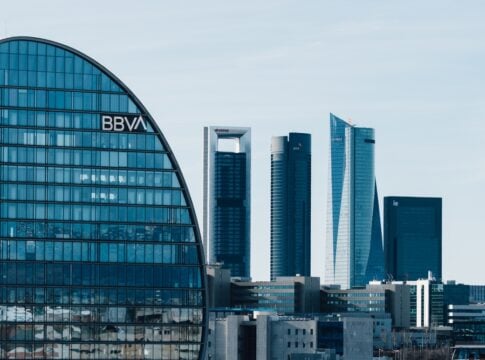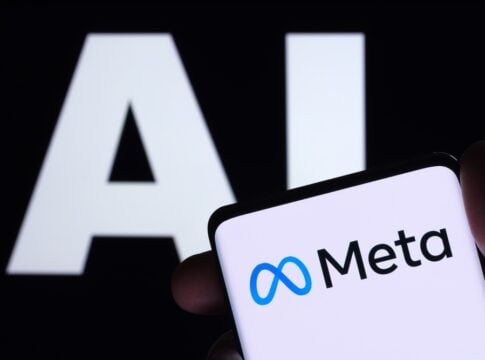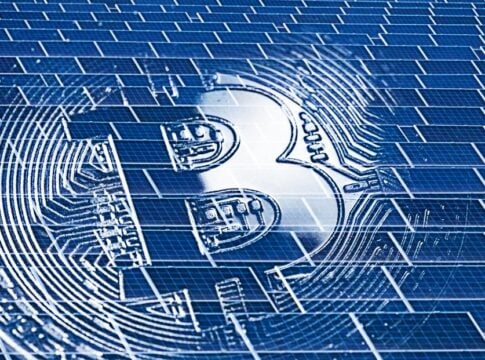Carbon Footprint
BBVA Hits €30 Billion in Q2 for Sustainable Finance
Spanish banking firm Banco Bilbao Vizcaya Argentaria, aka BBVA, has set a new pace in sustainable finance. The bank recently announced that it has mobilized €30 billion ($32.5 billion) in green and social projects in Q2 2025 — its highest quarterly result ever. This brought its total for the first half of the year to €63 billion ($68.5 billion), marking a sharp 48% jump from the same period in 2024.
From Climate Action to Social Impact: BBVA’s €63 Billion Green Push
The growth pushes BBVA closer to its new target: channeling €700 billion ($760 billion) into sustainable financing between 2025 and 2029. The bank had already met its earlier €300 billion goal for 2018–2025 a year ahead of schedule, hitting the milestone in December 2024.
Of the €63 billion mobilized in H1 2025, 76% went toward climate change and natural capital projects. These covered areas such as renewable energy, efficient water use, sustainable agriculture, biodiversity protection, and the circular economy.
The remaining 24% went to social projects, including infrastructure for education and healthcare, entrepreneurship support, funding for small businesses, and financial inclusion for underserved communities.
Record Growth Across Business Segments
BBVA’s momentum came from strong growth in all business lines:
-
Commercial Banking: Mobilized €23.6 billion, up 53% year-on-year. Natural capital financing totaled €2.34 billion, with Mexico’s agricultural sector contributing half of that.
-
Corporate and Investment Banking (CIB): Contributed €31.9 billion, up 34%. The bank financed clean technologies, renewable projects, and sustainable supply chain solutions such as reverse factoring with green criteria. Renewable energy project funding alone reached €1.6 billion.
-
Retail Banking: Channeled €7.5 billion, up 119%. This included €742 million for hybrid and electric vehicle financing and digital tools that help customers measure potential energy savings.
Backing Breakthrough Clean Energy Projects
BBVA’s sustainability push isn’t just about volume — it’s also about innovation. In Q2 2025, the bank sponsored the Energy Tech Summit in Bilbao, attracting over 1,500 cleantech experts from 40+ countries.
There, it announced a landmark project finance deal — the first in the Iberian Peninsula for a hydrogen plant powered entirely by renewable energy. Scheduled to begin operations in H1 2026, the plant will be a key step in decarbonizing heavy industry.
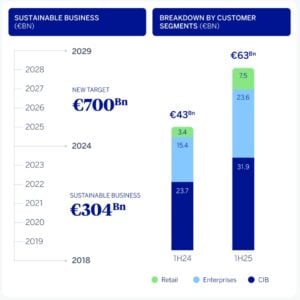
A More Ambitious €700 Billion Target
BBVA’s expanded goal more than doubles its previous plan, with a shorter deadline. The aim is to channel €700 billion in sustainable finance from 2025 to 2029, compared to the earlier €300 billion over eight years.
The strategy focuses on three pillars:
-
Climate Action – Funding renewable energy, clean technologies, and emissions reduction.
-
Natural Capital – Supporting agriculture, water conservation, biodiversity, and land restoration.
-
Social Opportunities – Financing healthcare, education, affordable housing, and entrepreneurship.
Driving the Net Zero Transition
Alongside its financing efforts, BBVA is working toward Net Zero emissions by 2050. It has already set interim 2030 decarbonization targets for ten sectors, including oil and gas, power generation, automotive, steel, cement, coal, aviation, shipping, aluminum, and real estate.
The bank is now preparing sector targets for agriculture — a major source of global emissions — as part of its broader climate plan.
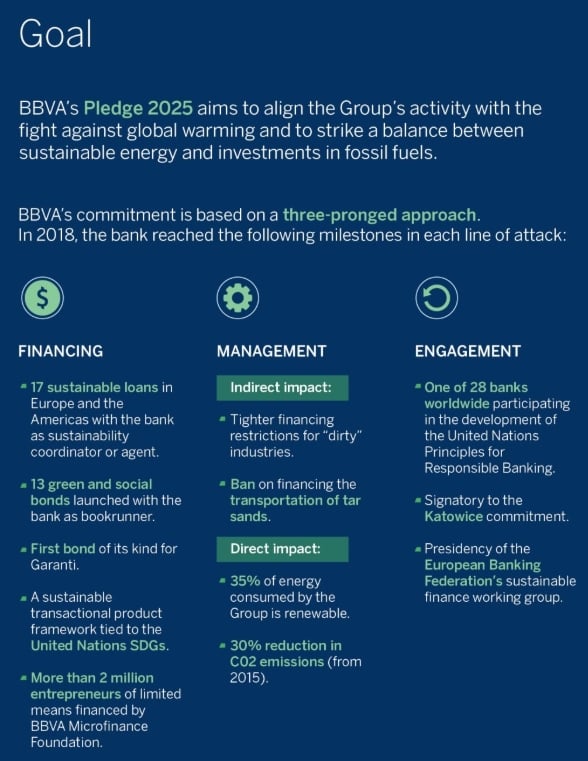
Why This €30 Billion Surge Matters
BBVA’s record-breaking quarter shows that sustainable finance is moving into the mainstream. The bank’s retail segment — up 119% — proves that demand for eco-friendly banking isn’t limited to corporations. Everyday, customers are increasingly choosing green loans, energy-saving solutions, and sustainable investment options.
These projects deliver dual benefits: reducing carbon footprints while improving social well-being. From renewable power plants to inclusive financing for small businesses, BBVA is aligning its growth with global sustainability goals.
How BBVA Plans to Hit the €700 Billion Mark
The bank’s roadmap includes expanding partnerships, scaling retail offerings, and enhancing digital sustainability tools. These platforms help clients understand the environmental impact of their investments, building transparency and trust.
For example, customers can estimate energy savings from home upgrades or track CO2 reductions from EV financing. By merging finance with real-time environmental insights, BBVA is turning sustainability into an accessible, measurable choice for more people.
Environmental and Carbon Benefits of These Investments
With 76% of funding directed to environmental projects in H1 2025, BBVA is investing heavily in emissions reduction, renewable energy, and ecosystem restoration.
Key highlights include:
-
Hydrogen & Renewables – €1.6 billion for renewable power and financing Iberia’s first renewable hydrogen plant.
-
Natural Capital – €2.34 billion for water conservation, sustainable agriculture, and biodiversity protection.
-
EV Transition – €742 million in hybrid and electric vehicle loans, cutting transport-related CO2.
These initiatives help replace fossil fuels, store carbon in healthier ecosystems, and encourage sustainable consumer behavior.
The Global Trend Fueling BBVA’s Growth
BBVA’s performance mirrors a global boom in sustainable finance. Green bond issuance could surpass €1 trillion annually by the end of 2025. Over 70% of large corporations now follow ESG strategies, driven by customer demand and regulatory pressure.
By beating its 2018–2025 target ahead of schedule and setting a new, more ambitious goal, BBVA is positioning itself among the leaders in climate-aligned banking. Its mix of green and social investments also supports the UN Sustainable Development Goals (SDGs).
Notably, its sustainability push comes with solid financial backing. The bank reported €5.45 billion in profit for H1 2025 and maintains strong capital reserves. Its “capital-light” growth model balances risk and return, keeping investors confident while pursuing long-term environmental impact.
What’s Next for Banking and Sustainability
The rise of ESG investing signals a shift in the role of banks. Customers, investors, and governments now expect institutions to be active players in the climate transition. BBVA’s quick pivot demonstrates its readiness to meet this demand at scale.
Going forward, expect more banks to adopt:
-
Clear Targets – Time-bound climate and social finance goals.
-
Transparency Tools – Digital platforms that track impact.
-
Innovation Financing – Support for emerging decarbonization technologies.
BBVA’s Role in Shaping the Future
From clean hydrogen plants to small business inclusion programs, BBVA’s sustainable finance strategy blends profitability with purpose. The bank is proving that climate action and social impact can be growth drivers, not just compliance measures.
Its combination of technology, strong performance, and measurable impact makes it a leader in the green banking race. As industries decarbonize and regulations tighten, banks that move early, like BBVA, will set the standard for the financial sector’s role in building a sustainable future.
The post BBVA Hits €30 Billion in Q2 for Sustainable Finance appeared first on Carbon Credits.
Carbon Footprint
Meta’s AI Forest Map: The Game-Changer for Carbon Tracking
Forests are vital for our planet. They help fight climate change by absorbing a lot of carbon dioxide from the air, acting as major carbon sinks. They store large amounts of carbon in biomass and soil, estimated to absorb about 30% of human-caused CO2 emissions annually worldwide.
However, scientists and project managers must track forest health. They need to know how much carbon forests store. This helps ensure that efforts to protect or grow forests are effective. This is called measuring, monitoring, reporting, and verifying forest carbon, often shortened to MMRV.
Eyes in the Sky: How Remote Sensing Sees Forests Differently
Measuring carbon in forests is tricky and expensive. Usually, people go out into the forest and measure trees by hand, which takes a lot of time and effort. It’s hard to do this over large areas, especially in dense or remote forests.
This is where remote sensing comes in.
Remote sensing is a way to gather information about forests without going there in person. It uses satellites, airplanes, or drones equipped with cameras and sensors. This technology can take pictures and collect data. It helps scientists learn how tall trees are, how dense the forest is, and how much carbon it might store.
There are different kinds of remote sensing data:
- Optical imagery: like normal photos taken from space or planes, showing the tops of trees and land features.
- Radar: which uses radio waves and can see through clouds and work at night.
- Lidar: which uses lasers to map the exact height and shape of trees in 3D.
The Challenge with Remote Sensing Data
Each data type has strengths and weaknesses. Optical images are good and widely available, but they can’t see through clouds and only show forest surfaces. Radar can see through clouds but has trouble measuring details in dense forests. Lidar is very accurate but expensive and covers less area.
To get the best info, scientists combine different types of data using artificial intelligence (AI) and machine learning techniques. Machine learning helps computers find patterns in huge amounts of data to make better estimates.
Meta’s Canopy Height Map: AI-Powered Forest Intelligence
Meta developed a unique AI model that merges high-resolution satellite images with lidar data. This model maps tree canopy heights globally with great detail—less than one meter per pixel. This means it can see individual trees in many places.
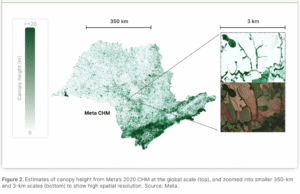
The map and the AI model are open-source and freely available, so anyone can use them to help forest projects. They enable better planning, monitoring, and verification of forest carbon projects. Reza Rastegar, Senior Manager of Research Science at Meta, stated:
“When applied thoughtfully, we believe AI research and remote-sensing tools, particularly those that are open source, have the potential to revolutionize the transparency and accessibility of the carbon market.”
Meta’s model has been validated with mean absolute errors of 2.8 meters in U.S. forests and 5.1 meters in Brazil. This reflects a promising improvement in estimating canopy height at fine scales. These advanced datasets and models are helping to track natural regeneration, selective logging, and forest degradation more accurately, which is vital for credible MMRV of carbon credits.
What’s special about this model?
- It works globally with very fine detail.
- It can help identify important areas to protect or restore.
- It can make new maps for different times if good images are available.
- It helps detect small changes in forests, like selective logging (cutting some trees but not all).
- It supports methods from carbon credit standards. This is important for those who need dynamic baselining or updating project baselines with real data from nature.
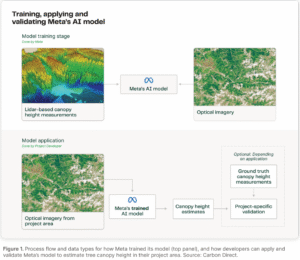
RELATED: Meta and Microsoft Secured Long-Term Carbon Credit Deals to Support Olympic Rainforest
From Pixels to Carbon Credits: Turning Data into Climate Action
Forest carbon projects use different official methods to create and verify forest carbon credits. The three main methods Meta focuses on are:
- Verra VM0045 – for improved forest management (IFM).
- Verra VM0047 – for afforestation, reforestation, and revegetation (ARR).
- American Carbon Registry (ACR) IFM – a US-based improved forest management method.
Here’s how Meta’s canopy height map and AI model fit into these methods:
- In project planning, the map helps find good parcels of forest to include, determine project boundaries, and understand forest structure.
- For dynamic baselining, especially in ARR and ACR’s IFM methods, the AI model can help update baselines based on real forest growth or loss over time.
- For reversals monitoring (tracking if carbon gains are lost, e.g., due to fire or logging), the map gives better details to detect forest disturbances.
The Fine Print: What Meta’s Model Gets Right—and Where It Struggles
Many traditional satellite products can’t reliably measure forest height or biomass in dense forests or small areas. Meta’s model, because it uses very high-resolution images, helps overcome this.
Monitoring small or fragmented forests, river corridors, or areas with selective logging is crucial. These places are difficult to track using low-resolution data.
Meta’s canopy height model is a powerful tool for estimating forest structure, but it comes with limitations. It works best with high-quality imagery at 0.5–1 meter resolution. The global canopy height map uses images from 2009 to 2020. This means it might not show current forest conditions. So, there’s a need for updated maps.
Accuracy may also drop in underrepresented forest types, so local validation with field or lidar data is advised. Using the model requires significant computing power and technical expertise, which may limit adoption.
For forest carbon projects, remote sensing offers great promise but faces barriers. There is no universal agreement among registries, buyers, and developers on acceptable methods or datasets.
In addition, technical skills, computational capacity, and access to affordable, high-quality datasets remain limited. Uncertainty around accuracy—and lack of consensus on acceptable error levels—make trust and comparability difficult.
For the identified barriers, the report authors recommend the following:
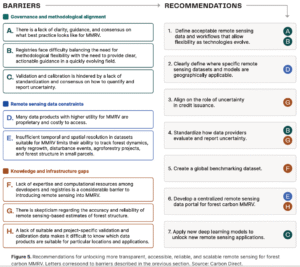
Closing the Gap Between Innovation and Impact
Experts want clearer standards for how datasets can be used. They also seek better reporting on uncertainty and clearer rules for issuing carbon credits. A global benchmarking database with verified data and a central portal for quality datasets could help boost adoption.
Moreover, easier AI tools would make this process smoother. Integrating advanced models like Meta’s into accessible platforms, alongside collaborative standard-setting, will be crucial to scaling reliable forest carbon monitoring and verification.
Examples of New and Exciting Uses of Meta’s Model
- Counting trees in agroforestry projects to monitor performance.
- Mapping old-growth forests and biodiversity hotspots.
- Detecting subtle forest degradation, like selective logging.
- Monitoring reversals (losses of carbon stored) with greater accuracy.
- Supporting more accurate estimates of above-ground biomass.
Forests are vital to fighting climate change by storing carbon, but measuring how much carbon they hold and how this changes over time is tough. New technologies like remote sensing are making this easier, faster, and cheaper.
Meta’s AI-powered canopy height map is a cutting-edge tool offering very detailed, global forest height data that can help in planning, monitoring, and verifying forest carbon projects.
The post Meta’s AI Forest Map: The Game-Changer for Carbon Tracking appeared first on Carbon Credits.
Carbon Footprint
PowerBank Embraces Bitcoin and Tokenized Energy in Bold Treasury Shift to Digital Finance
Disseminated on behalf of PowerBank Corporation.
PowerBank Corporation recently announced a new treasury strategy that includes holding Bitcoin. This move combines innovative finance with the company’s ongoing mission to develop clean energy projects. PowerBank aims to hold Bitcoin on its balance sheet. It has also teamed up with Intellistake Technologies Corp., a company focused on blockchain and digital asset custody and treasury management.
PowerBank intends to acquire Bitcoin as part of its treasury assets. This allows the company to tap into the long-term value of the cryptocurrency. Also, it remains dedicated to environmental responsibility and sustainability.
Linking Bitcoin with Clean Energy
Bitcoin mining is often criticized for high energy consumption and its impact on the environment. Some experts and companies think Bitcoin can help renewable energy grow. This is true when it is linked to clean power sources. That is the approach PowerBank follows.
PowerBank states that all Bitcoin transactions it completes will use net cash flow from verified renewable energy sources. This helps maintain its focus on sustainability.
So, Why Bitcoin?
PowerBank views Bitcoin not just as an investment but as a strategic reserve asset. Holding Bitcoin on its balance sheet can help the company hedge against inflation and economic uncertainty. This trend includes more than 40 public companies that hold Bitcoin as of 2024, says Galaxy Digital.
Bitcoin is decentralized and has a limited supply of 21 million coins. This makes it appealing for companies that want a long-term hedge against inflation. PowerBank has committed to transparency with its future Bitcoin holdings and will report them openly.
A Smart Power Duo: PowerBank x Intellistake
PowerBank has teamed up with Intellistake Technologies Corp. This partnership will help PowerBank with technical advice, custody, digital asset security, blockchain infrastructure, and treasury management. All these services support PowerBank’s Bitcoin strategy and related plans.
Through this collaboration, the company gains access to Blockchain infrastructure and digital asset custody.
Expanding Clean Energy Finance Through Digital Assets
PowerBank’s Bitcoin strategy positions it as a pioneer in linking digital assets with clean energy development. Bitcoin purchases with net cash flow generated from renewable energy can offset the electricity used in Bitcoin mining.
Research from groups like the Energy Web Foundation and the Cambridge Centre for Alternative Finance backs this idea. Using low-carbon energy for Bitcoin mining can turn it from a problem into a tool for grid management, and PowerBank is using a similar indirect approach through the use of net cash flow from renewable energy projects to acquire Bitcoin.
The announcement has attracted attention from ESG-focused investors and the broader crypto community. It shows a rising interest in how renewable energy developers can use blockchain and digital assets in their financing models.
A Bloomberg NEF survey found that approximately 60% of renewable energy developers are exploring blockchain or digital asset solutions to support project financing. If PowerBank’s approach works, it may inspire other clean energy companies to try similar strategies.
Beyond Bitcoin: Energy on the Blockchain
In addition to Bitcoin, PowerBank is advancing blockchain-based finance through its partnership with Intellistake. Intellistake specializes in blockchain, capital markets, and decentralized AI infrastructure.
Under this agreement:
- PowerBank plans to accumulate Bitcoin as a long-term reserve asset.
- Intellistake provides custody, digital security, and treasury management tools.
- Both companies will look into tokenizing real-world energy assets. This includes solar farms and battery storage systems.
Tokenization is turning physical assets into digital tokens. These tokens can be traded or sold in regulated markets. This can lead to:
- Easier access to renewable energy investments.
- Faster, transparent transfers of ownership.
- New ways to raise capital through fractional ownership.
Intellistake’s CEO, Jason Dussault, has stated that tokenization is no longer just a concept but an inevitable step for capital markets.
Analysts say tokenized real-world assets might reach a $30 trillion market by 2034, while some projected it to reach almost $19 trillion by 2033. Clean energy is a major use case because of its stable, asset-backed value.
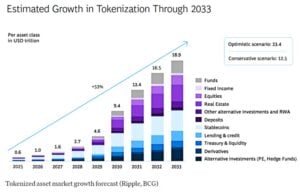
Reasons for Bitcoin as a Treasury Asset
PowerBank’s Bitcoin treasury plans reflect a broader corporate trend. Many companies view Bitcoin as:
- Scarce and resistant to inflation.
- Easily transferable with global liquidity.
- Increasingly adopted by blockchain-based financial systems.
Firms like MicroStrategy, Block, and Tesla have added Bitcoin to their balance sheets to diversify reserves beyond bonds and cash. PowerBank has not yet confirmed any Bitcoin purchases.
The company plans to make decisions based on market conditions, liquidity needs, and cash flow. PowerBank wants to keep full control of its digital assets. So, it has Intellistake providing custody infrastructure, which means no need for third parties.
A New Model for Clean Energy Finance
PowerBank generates steady revenue from its renewable energy projects. The company might use these revenues to invest in digital assets. They plan to connect clean energy with advanced financial technologies.
PowerBank has developed over 100 megawatts (MW) of renewable energy projects in the U.S. and Canada. It also has a pipeline of about 1 gigawatt (GW). This gives PowerBank a solid base to try out new financing methods.
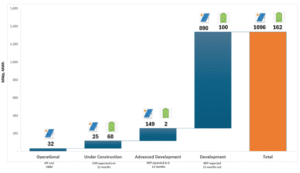
The company’s integration of Bitcoin and tokenization may change how energy developers manage their finances. The company intends to combine renewable energy projects with treasury diversification and blockchain finance. This approach opens a new frontier for decarbonization and financial technology.
As investors and utilities seek sustainable, high-yield options, PowerBank’s approach could open new value opportunities in both the energy and finance sectors.
Please refer to “Forward-Looking Statements” in the press release entitled “PowerBank and Intellistake Announce Strategic Alliance to Pioneer Digital Currencies, including Bitcoin Treasury Integration and RWA Tokenization” for additional discussion of the assumptions and risk factors associated with the statements in this report.
Intellistake and PowerBank are presently evaluating the regulatory framework for tokenization. Any tokenization will be subject to it being completed in compliance with applicable law, regulatory requirements and terms of any underlying agreements associated with PowerBank assets. The actual structure of such tokenization, the assets that would be subject to tokenization, and the associated timeline, have not yet been determined. Intellistake and PowerBank will provide further updates as material developments related to this tokenization strategy occur.
The actual timing and value of Bitcoin purchases, under the allocation strategy will be determined by management. Purchases will also depend on several factors, including, among others, general market and business conditions, the trading price of Bitcoin and the anticipated cash needs of Intellistake or PowerBank. The allocation strategy may be suspended, discontinued or modified at any time for any reason. Intellistake will support PowerBank’s establishment of custody for its digital currency purchases and PowerBank no longer intends to utilize Coinbase for this service. As of the date of this press release, no Bitcoin purchases have been made.
Disclosure: Owners, members, directors, and employees of carboncredits.com have/may have stock or option positions in any of the companies mentioned: None.
Carboncredits.com receives compensation for this publication and has a business relationship with any company whose stock(s) is/are mentioned in this article.
Additional disclosure: This communication serves the sole purpose of adding value to the research process and is for information only. Please do your own due diligence. Every investment in securities mentioned in publications of carboncredits.com involves risks that could lead to a total loss of the invested capital.
Please read our Full RISKS and DISCLOSURE here.
The post PowerBank Embraces Bitcoin and Tokenized Energy in Bold Treasury Shift to Digital Finance appeared first on Carbon Credits.
-
Climate Change2 years ago
Spanish-language misinformation on renewable energy spreads online, report shows
-
Climate Change Videos2 years ago
The toxic gas flares fuelling Nigeria’s climate change – BBC News
-

 Greenhouse Gases1 year ago
Greenhouse Gases1 year ago嘉宾来稿:满足中国增长的用电需求 光伏加储能“比新建煤电更实惠”
-

 Climate Change1 year ago
Climate Change1 year ago嘉宾来稿:满足中国增长的用电需求 光伏加储能“比新建煤电更实惠”
-

 Carbon Footprint1 year ago
Carbon Footprint1 year agoUS SEC’s Climate Disclosure Rules Spur Renewed Interest in Carbon Credits
-
Climate Change2 years ago
Why airlines are perfect targets for anti-greenwashing legal action
-
Climate Change Videos2 years ago
The toxic gas flares fuelling Nigeria’s climate change – BBC News
-
Climate Change2 years ago
Some firms unaware of England’s new single-use plastic ban

